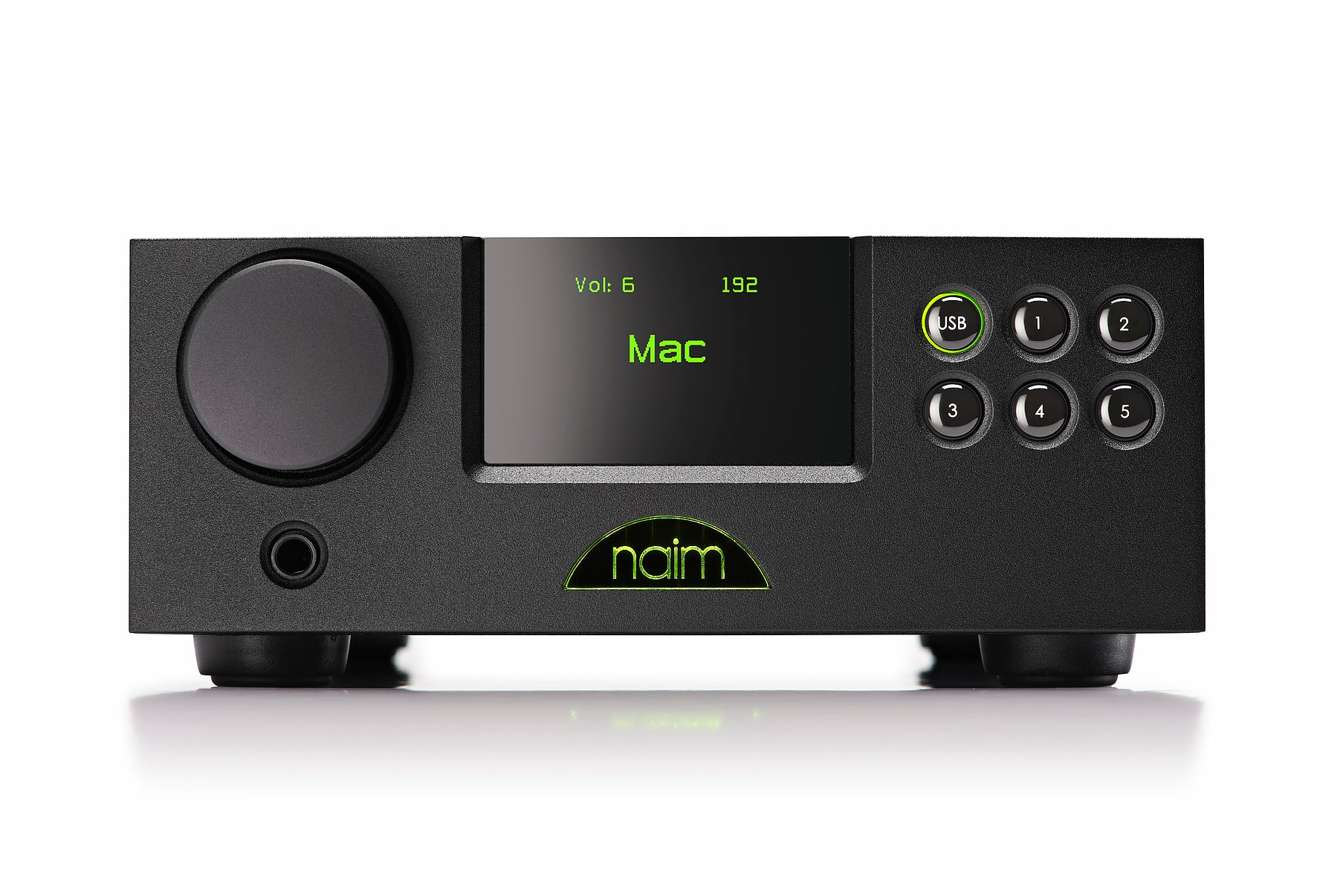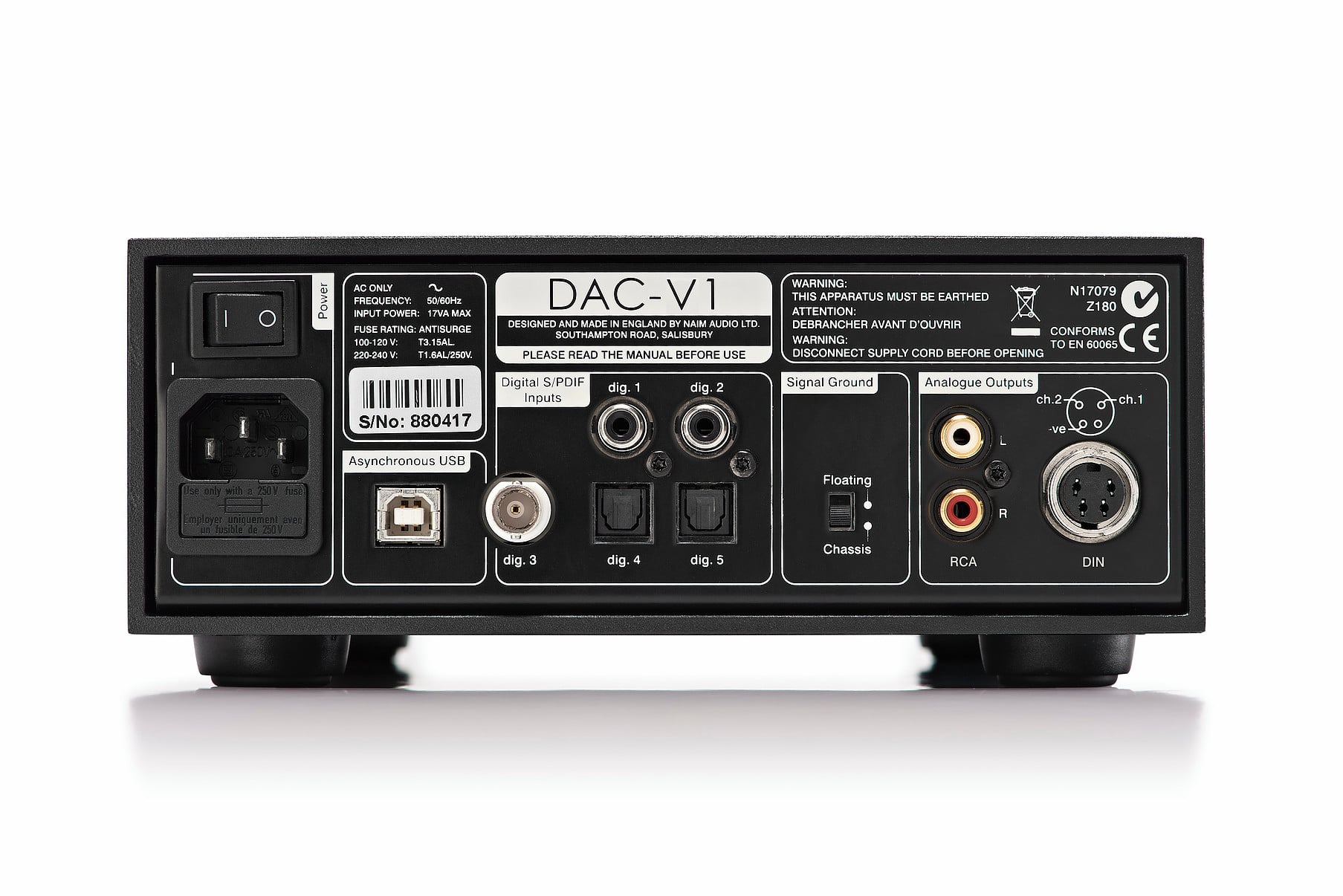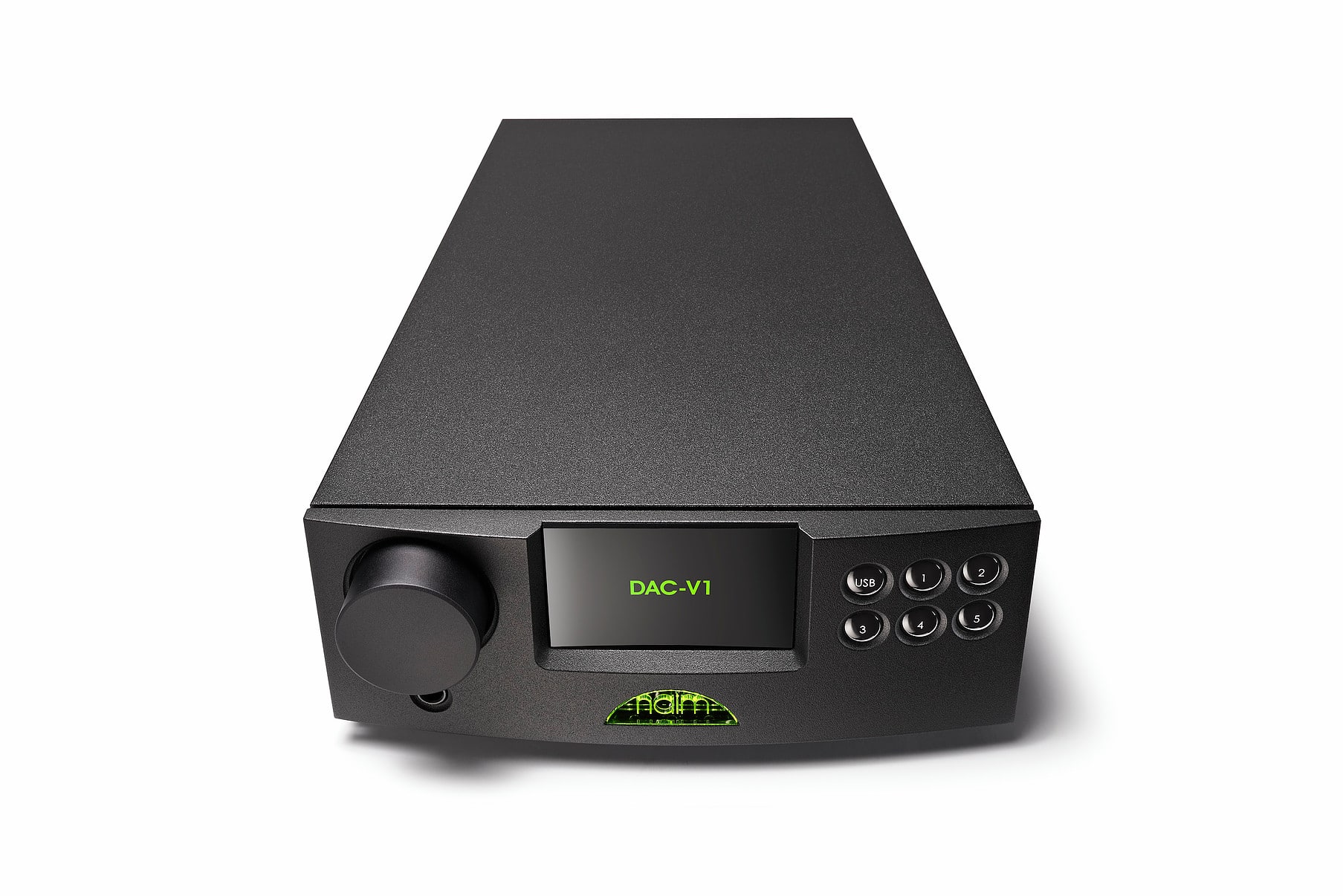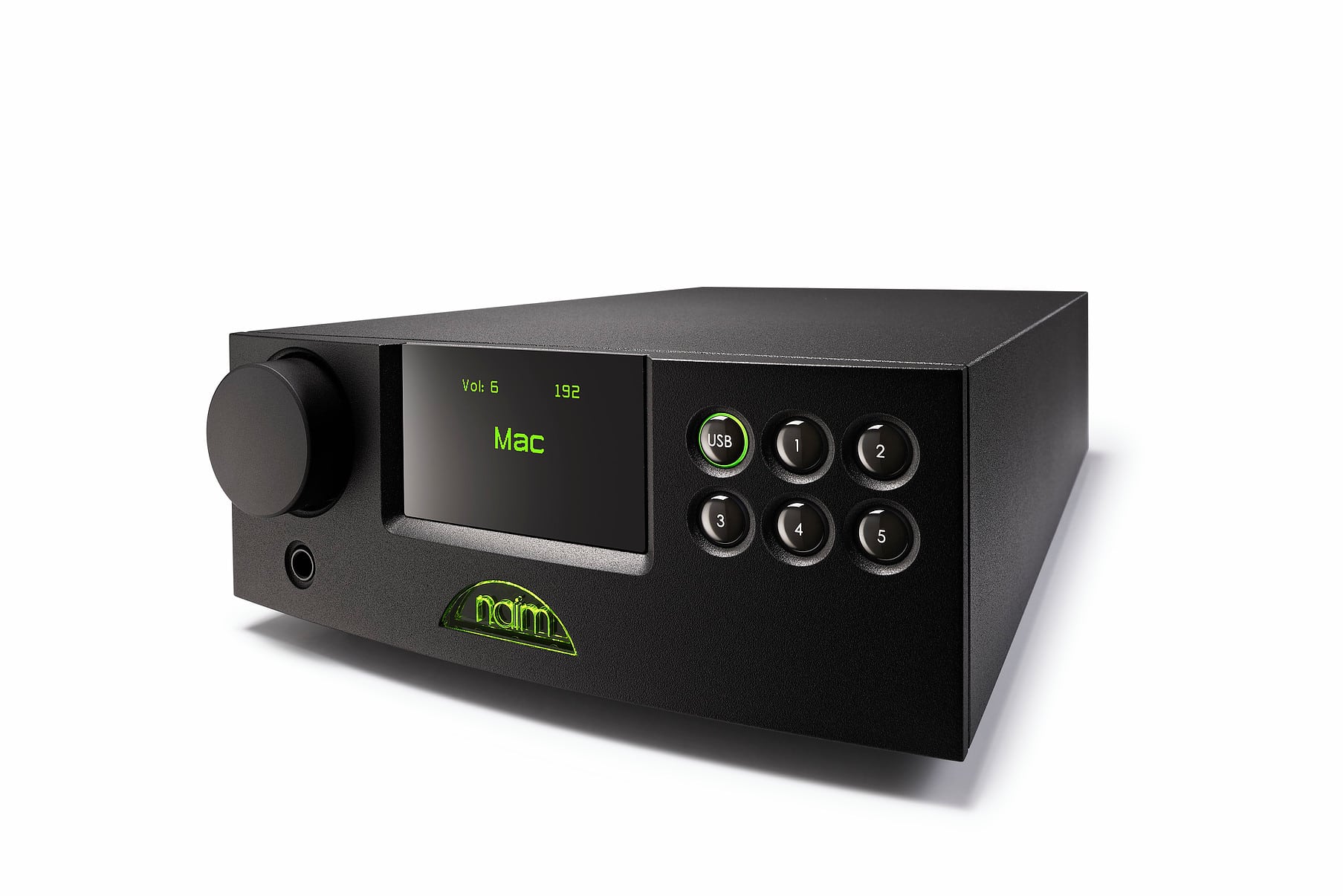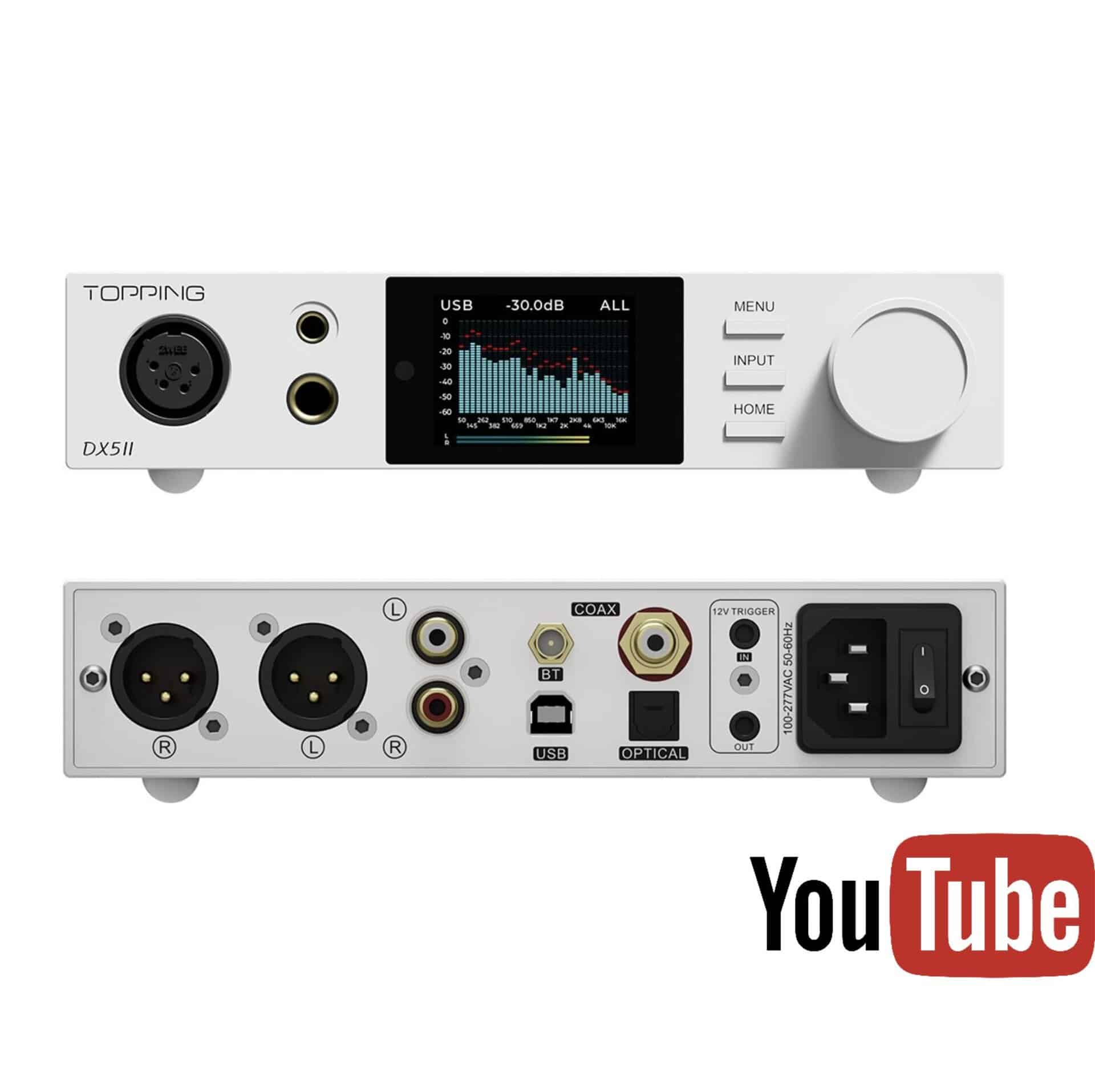The Article
Naim V1 DAC adds DSD: Paul Rigby interviews designer, Steve Sells
21st February 2016
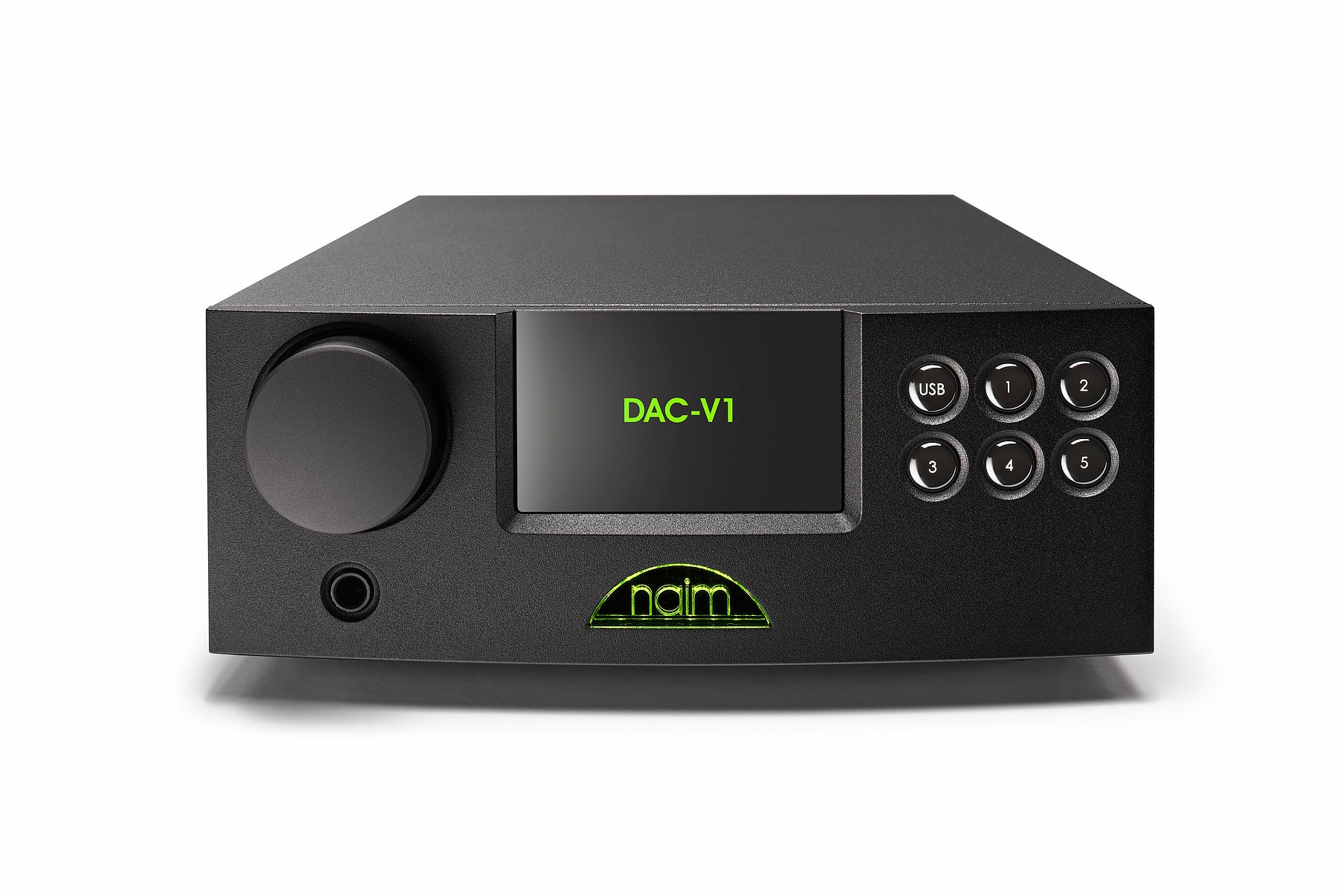
Naim has released a DSD update for its V1 DAC. Paul Rigby reviews it and talks to Naim designer, Steve Sells about the general design while Sells reveals a few DSD home truths
You could say that Naim’s V1 was the brainchild of a sales man. In this case, sales director, Doug Graham. As he travels the world, Graham is often in a position to gauge demand for new products. In this case, a compact, half size DAC, that you can hook up to a computer, offering a headphone output combined with a DAC.
What Naim has produced includes, on the front fascia, five input buttons plus a sixth, USB-labelled, button, a rotary volume knob, full size headphone socket and message window that sits just above the illuminated Naim logo. The rear of the chassis features two RCA digital connections, one BNC and two TOSLINKs, one high speed USB, a floating/chassis ground switch, analogue RCA outputs and a Naim DIN for an optional, external NAP 100 power amplifier (retailing at around £700) as well as an IEC power socket.
One of the input highlights is the asynchronous USB which was developed with an unnamed American company for a year and half. Naim realised that there were cheaper options out there but this example was chosen because the set-up was simpler for users. According to Naim, various asynchronous USB hardware does differ in sonic quality but the nub of those sound quality differences are based on how you lay out and implement an asynchronous USB rather than the actual technology that you are using. The V1’s example can handle up to 24bit/384MHz and DSD128. Steve Sells, Naim’s Electronics Design Director explained that, “I designed parts of the V1. I tend to design core new technology and then the engineers take that on. The V1 contains technology from the earlier Naim DAC, also known as the nDAC.”
As you can see in the images, the V1 has a variety of digital inputs but some offer higher specifications the others, “Optical is limited to 24bit/96kHz with 24bit/192kHz on S/PDIF,” said Sells. “There’s no analogue inputs which, I know, is a bit of a disappointment for some people but, do you know, it was one of the longest and hardest decisions we had but we tried to focus on what the product does best. If you put everything in the digital domain then you can make some changes that give you an advantage. For example, the volume control – a Naim design – that uses expensive parts and is based on the Statement system.”
You might think, “Volume? So what? What’s the fuss about?” On the face of it, you’d be right but not too many people are aware that the ultimate sound quality of a pre-amp and even a DAC like the V1 can be made or broken by the volume control area. It’s actually an essential and sensitive area.
Although the V1’s volume control is ‘based’ on the top-of-the-range Naim Statement system, it is not directly copied from it. This example was tweaked, “We cut out one third of the volume circuit,” said Sells.
Why? Budget reasons, basically but although the volume area is restricted to 64db, Sells tweaked the part so that you get the best bits from the volume control, “We fill that volume circuit in, at the bottom, in the digital domain and so you get that really great thing where digital and analogue are working together to give you value for money.”
Hence, for this quality volume control, all the main listening range, down to tape hiss levels, is all done in the analogue domain which relies on the expensive bit of the volume control. To be able to fade the volume down nicely or have really quiet music then Naim starts using digital attenuation in the quiet bits via a DSP (which performs some quick maths on the audio by using 40bit floating bit precision). Hence, when you get down to -100db, you’re looking at 64db of loud analogue and the rest is quiet digital, “On an engineering level,” said Sells, “it makes absolutely sense: its cheaper, smaller and more efficient with the same result.”
Let’s play devil’s advocate for a moment. If budget is a concern and you’re trying to push out the V1 at a reasonably affordable price, for this class of DAC, why not go for a cheaper volume control, why utilise such a high quality volume control in the first place? “We could have cut quality corners but ‘volume’ is one of those incredibly delicate things. There’s some good chips out there but they don’t quite get the sound that we want. We do use, in fact, a National chip on other products that doesn’t have the specifications of other chips but does have a sweet sound but it’s not up to the level that we wanted for the V1.”
Sells doesn’t believe that, for a box that will sit in a ‘mere’ study or a relatively bustling and slightly non-audiophile space such as an office, that employing such high quality components show that Naim may have gone overboard, “You can get into that trap, sure but, for us, we see it as a pre-amp as well so it can be connected to an amp and speakers in a top flight hi-fi. Also, if you are spending all that money on a DAC then you are probably spending a significant amount on other products to connect to it.”
The V1 utilises a Burr Brown PCM1791A which is one of that company’s 24bit/192kHz DACs with a voltage output. There is just the one DAC inside the V1 chassis, no dual monos and the like because, again, of budget concerns. The DAC itself, says Sells, “…is incredible value for money. When a lot of developers use it, they use the digital filter. Because we’ve got a separate DSP in there, though, we are doing jitter reduction on the S/PDIF and oversampling filter. Hence we are using only the back-end of the DAC chip which means that we can pull a lot of quality out of it than you would ordinarily. We’ve replaced the Burr Brown filter in the chip with our own 40bit floating point one, we developed that with the nDAC. So, for this 192kHz chip, we can actually get 768kHz out of it. On this product, because we can’t get the digital audio into the product fast enough, it’s limited to 384kHz.”
The next key part of the design was the decision to use a toroid transformer drived from Nuvotem, in Ireland, “We’ve been using that company for years. We gave a base design to their guys and then we created iterations. Great thing about a toroid is that you don’t have switching frequencies so you haven’t got to manage getting rid of 60kHz noise and it isolates from the mains most of the time.”
As for the output stage? This is the same output stage that Naim uses in its big, preamplifiers, like the 252 to the 552, “A current feedback single-ended Class A is used in the V1,” said Sells. “It offers low noise for small signals and, when you crank it up, then it only produces a bit of second order distortion but by then it’s so loud the ear isn’t hearing it. It works really nice. When you plug your headphones in, though, we ramp up the single-ended Class A so there’s enough current to run headphones.”
So we finally come to the new upgrade. The V1 can now support DSD. Why the upgrade? “Market pressure – especially from the Far East,” said Sells. “People want to have fun with hi-res files, its part of the hobby.”
There’s so many ways to ‘do’ DSD, it’s a tough subject. Naim has a DAC in the V1 which, on the data sheet, says is ‘DSD compatible’ but, if you drilled down inside, what is actually happening in these modern DSD DAC chips? “You’ll find,” said Sells, “that it’s not pure DSD. It’s converting the DSD into a multi-level 1bit signal. You have to forget about the ‘It’s DSD, well keep it pure’ thing because, with the best will in the world, it’s probably been through some PCM processing before it’s got to you. Getting a DAC that is 100% DSD is nigh on impossible. If you look under the hood of DSD chips, what they are all doing to DSD signals is not DSD any more.”
Which is a bit of a shock and also terribly confusing, isn’t it? You thought that your DSD kit, which apparently supports DSD, was playing DSD. But…it isn’t. Not really. Not like you’d think, at any rate. Apparently, the best DAC chips that you can get are multi-bit DACs but multi-bit DACs are just ridiculous to manufacture. A 24bit, multi-bit DAC features something called a ladder network. There are 24 ‘rungs’ on a ladder network in there using resistors. But to work in such a chip, such resistors have to be pretty special. Too special, it seems, “A resistor’s tolerance that you need to make for a DAC chip to 24bit standard is 0.000005%, which is more accurate than any resistor that has ever been made on Earth (which happens to be a ‘mere’ 0.005%, which is still incredibly accurate for a resistor). People are making 32bit DAC chips but others are saying, ‘Hang on, we’ve only just got to 20bit resolution and even 20bit requires a tolerance beyond what we can really manufacture.”
Hence, the best multi-bit DAC that you can buy today is probably the PCM1704 by Burr Brown and that’s probably ‘only’ reaching figures of around 16bit or 18bit resolution (in its true sense) with the rest generated by correlated noise.
It’s rather worrying, isn’t it?
Which was why, when the 1bit chip appeared on the scene, it seemed, at first glance, to solve the DSD problem. When they appeared, they were a pleasure for manufacturers because they were easy to produce. Especially when you consider that multi-bit DACs demanded such incredible accuracy that 90% of them were being rejected in the factory. Hence, the new 1bit chip offered ease of use in manufacturing with plenty of resolution, they seemed to be magic chips. You can sense a ‘but’ arriving, can’t you? Well, yes, there is one. Problem with 1bit chips is that they don’t sound as good as a properly fettled multi-bit chip. What to do? The industry decided to blend the two types of DACs together. Hence, nowadays, 1bit DACs often have five separate bits inside. So modern DACS often have five 1bit DACs that combine together to give you the best of both worlds. They are easy to manufacture and they offer pretty good accuracy. And that is why these chips are called ‘DSD Compatible’.
“Really, what they are doing is changing their built-in digital filter. What you end up with is not pure DSD: it has been manipulated. We have a 5-level Delta Sigma DAC in the V1 which is the same sort of technology that high-end DACs use with DSD. What we have in the V1 is a Sharc DSP processor. We take the DSD file and put it in a format where the DAC chip works best. So we take one bit and convert it to that format and we bypass the internal digital filter. In a way, it is more pure than other ‘DSD’ chips. We don’t convert to PCM. If we did, people would feel that they were being short-changed,” said Sells.
Before we get to the broader sound tests, the one aspect of the overall design of the V1 DAC that bothered me a little – and, I must admit, it’s being rather picky – is that some of the more essential controls are only available via the lightweight remote. If this remote goes AWOL then you cannot access the Settings on the DAC or the useful Mute button. I understand that the less buttons that are resident on the chassis itself, the better the sound quality so ‘ho hum’, I suppose. Even so, it does rankle a little bit.
SOUND QUALITY
I began with a WAV file from Carol Kidd and A Nightingale Sang in Berkeley Square from the Linn Records CD, Dreamsville, playing the file via USB and my SSD-powered MacBook through Audirvana. Fronting a jazz trio, Kidd offered a comprehensive, full and richly toned lead vocal. An acoustic guitar, which enjoyed a solo, later in the track, was both detailed and brisk. The strings danced over the soundstage providing an intricate display while the piano provided a melodic accompaniment that showed none of the usual blooming from this complex instrument. Finally, bass was not only powerful and hefty but moved at quite a pace.
Next was Bob Marley and I Shot the Sheriff at 24bit/96kHz from his Greatest Hits package. Playing this track via my Astell & Kern AK120 via the Naim’s optical port, I was impressed both by the Naim’s richness and complexity but also by the available space which seemed to infuse the soundstage. The expanded soundstage had a decidedly airy nature which allowed both the vocalists and instrumentalists time to manoeuvre which produced a relaxed and composed performance. The extra space in and around the soundstage pulled the backing vocalists left and right, giving the performance a sense of grandeur.
Speaking of those backing vocalists, there was an interesting complexity in and around their delivery. Interesting because the Naim teased each element of the harmony so that the ear could now discern each voice as it contributed to the whole.
As for the lead vocal of Marley himself? He brought an emotional response to the song which added texture, giving his delivery nuance and delicacy.
Percussion was sharp and responsive while keyboards featured a noticeable degree of reverb that gave the mix weight. That weight was also present in and around the bass response which featured character and form instead, as can often happened with DACs, a formless mush.
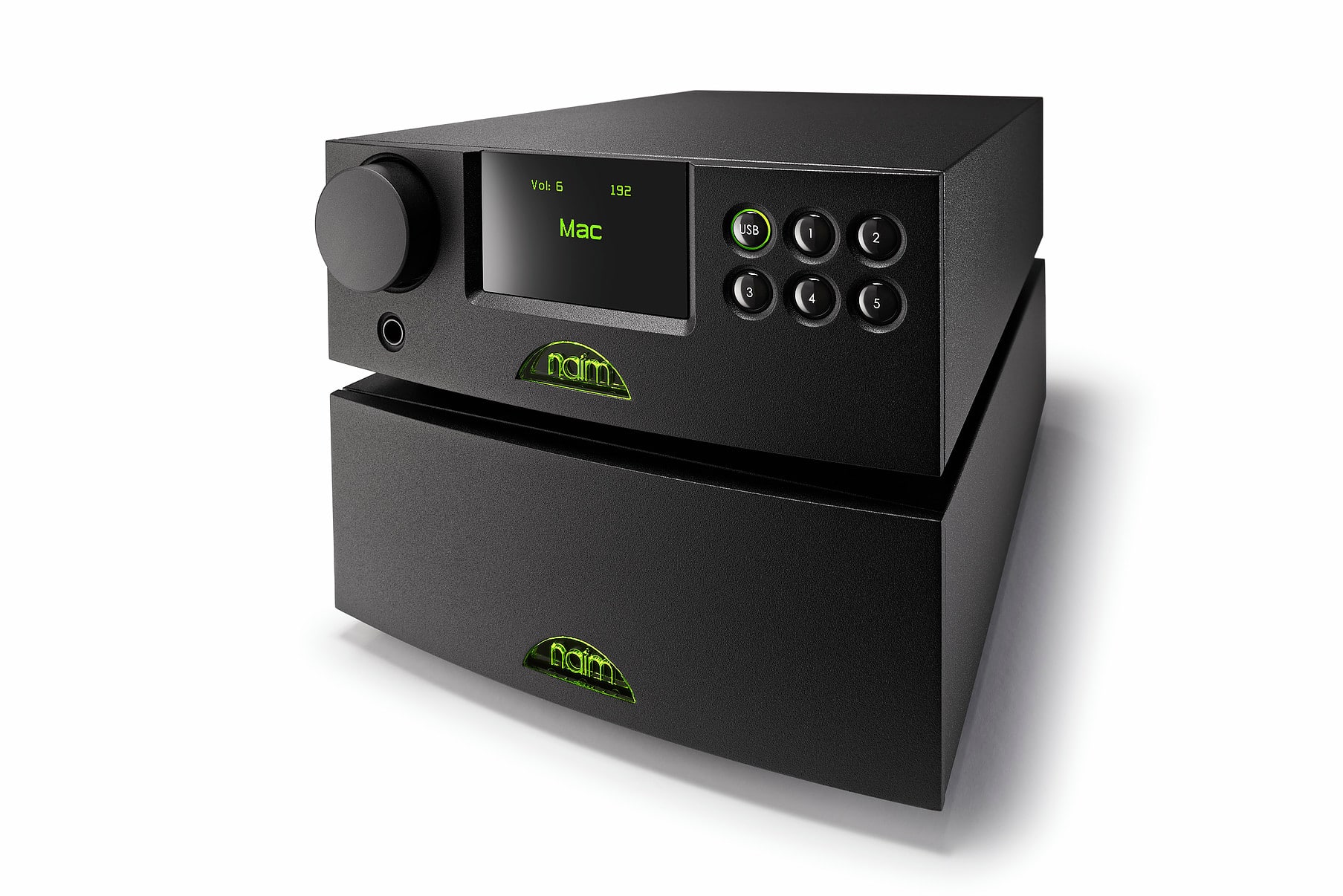
In general terms, upper mids showed great precision and could be finely etched which could be heard in and around vocal crescendos and guitar solos. That is not to infer that there was any hint of brightness here. Not so. What Naim has done, though, is to push the upper mid frequencies as far as they can before brightness becomes an issue. This sonic aspect might sound a little tense to some ears but the fact that Naim stops short of any brightness means that detail is always foremost.
Maintaining this train of thought, in terms of detail production, I quickly tested this file in a near field office situation using my Apple iMac and a pair of Roth speakers plus Rega amp. The attention to the upper mid detail meant that, even at lower volumes, music via the Naim was easily discernible. Guitar performance was exacting and intricate, vocals were expressive while there was enough bass, even at lower levels, to balance the performance.
Moving back to my main reference hi-fi and the essence, in many respects, of this entire review. How would the DAC perform while playing DSD files? For that, I turned to The Pixies and Bone Machine which, I have to tell you, hit me square between the eyes and left me unconscious for around four hours. Well, I might be exaggerating a tad but DSD on the Naim is delivered with a fair ol’wallop. The energy is almost pervasive. It solidifies around you, bullies you into handing over your lunch money, beats you up after you do and then leaves you bleeding in the gutter. It can be quite a shock.
To investigate the sound slightly more analytically, vocals sounded far more open and offered heaps of personality. Frank Black sounded positively sarcastic, at times. When he sang, in the following track, Broken Fist, you really felt for the guy. He winced in pain.
Other detailed highlights were not necessarily the stars of the show but where very important in terms of insight. The rhythm guitar, for example, was gloriously open in its approach. Such was its appeal that the detail inside this ‘open’ sound pulled me from the vocal performance to this repetitive background instrument.
Bass? It was not only solid but meaty with enough weight to fall through your listening room floor. It drove Bone Machine along with energy and force, giving it a solid foundation upon which the detailed upper mids played and frolicked.
Moving to the DSD version of Miles Davis’ Sketches Of Spain and Will O’ The Wisp, Davis’ trumpet had a subdued output but was wholly resonant so still produced plenty of emotion that formed the base of the track. While bass was pushed back in the mix, it still was ever present and never subsumed underneath the dominant brass. Meanwhile, secondary percussion from the castanets were sharp, precise and tonally fascinating.
I also tested the built-in headphone socket with my reference Sennheiser HD800s. The V1 DAC’s headphone stage, although it might not have the richness or rounded, balanced frequencies that you will hear on a more specialised and expensive Icon Audio HP8 Mk.II headphone amplifier, for example, does offer a good overall sound quality and proves to be a very useful freebie.
CONCLUSION
This is a fully featured DAC that offers a lot for the price in terms of facilities and sound quality. The fact that it does so in a neatly sized chassis adds flexibility in terms of positioning and how it can be utilised within an office and small room environment. That it provides high quality sound in both full-sized hi-fi and near field environments, at lower volumes is a welcome bonus while the build quality helps to ensure a long and productive life. The extra DSD sound option is a (pretty large) cherry on this particular cake, which not only adds to the feature count but gives you an impressive sound response.
NAIM DAC-V1
Price: £1,350
Website: www.naimaudio.com
(If you already own a V1, you can find a link to update your DAC-V1 to DSD standard at: www.naimaudio.com/updates When you land on the page, scroll down to the DAC-V1 area.)
Tel: 01722 426 600
Good: near-field performance, dynamic and energy-filled sound, feature laden, DSD sound quality, flexibility
Bad: remote-unique controls
RATING: 8
REFERENCE SYSTEM
Apple Macbook (SSD)
Apple iMac
Fostex HPA8C DAC
Astell & Kern AK120 DAP
Rega Brio-R integrated amplifier
Icon MB845 Mk.II monoblocks
Aesthetix Calypso pre-amp
Quad ESL-57 One Thing modified speakers
Roth RA1 speakers
Vertex AQ & Atlas cables

